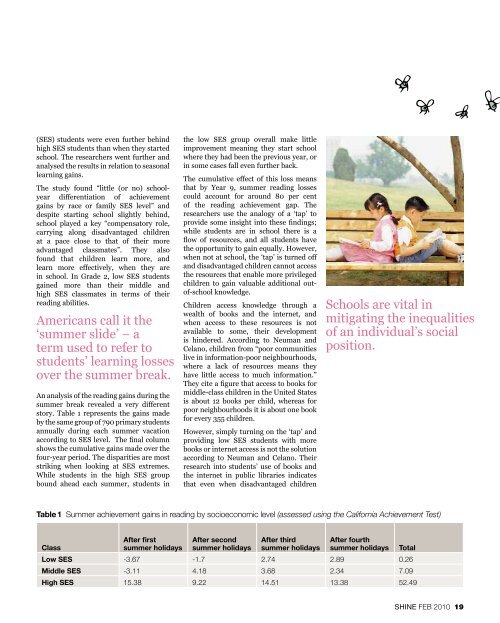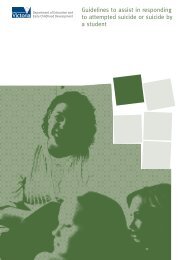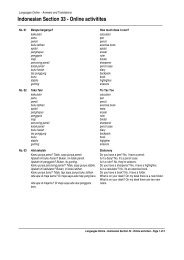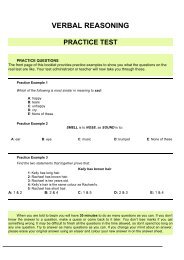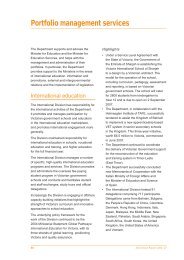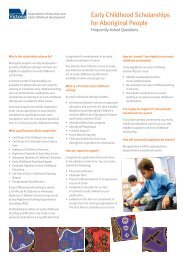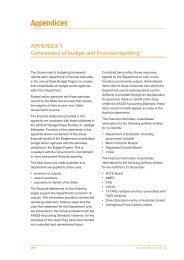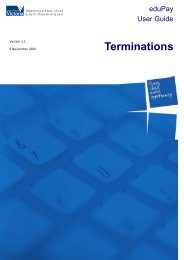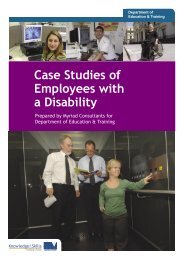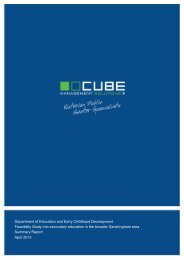Shine Magazine, Issue 1, February 2010 - Department of Education ...
Shine Magazine, Issue 1, February 2010 - Department of Education ...
Shine Magazine, Issue 1, February 2010 - Department of Education ...
- No tags were found...
Create successful ePaper yourself
Turn your PDF publications into a flip-book with our unique Google optimized e-Paper software.
(SES) students were even further behindhigh SES students than when they startedschool. The researchers went further andanalysed the results in relation to seasonallearning gains.The study found “little (or no) schoolyeardifferentiation <strong>of</strong> achievementgains by race or family SES level” anddespite starting school slightly behind,school played a key “compensatory role,carrying along disadvantaged childrenat a pace close to that <strong>of</strong> their moreadvantaged classmates”. They als<strong>of</strong>ound that children learn more, andlearn more effectively, when they arein school. In Grade 2, low SES studentsgained more than their middle andhigh SES classmates in terms <strong>of</strong> theirreading abilities.Americans call it the‘summer slide’ – aterm used to refer tostudents’ learning lossesover the summer break.An analysis <strong>of</strong> the reading gains during thesummer break revealed a very differentstory. Table 1 represents the gains madeby the same group <strong>of</strong> 790 primary studentsannually during each summer vacationaccording to SES level. The final columnshows the cumulative gains made over thefour-year period. The disparities are moststriking when looking at SES extremes.While students in the high SES groupbound ahead each summer, students inthe low SES group overall make littleimprovement meaning they start schoolwhere they had been the previous year, orin some cases fall even further back.The cumulative effect <strong>of</strong> this loss meansthat by Year 9, summer reading lossescould account for around 80 per cent<strong>of</strong> the reading achievement gap. Theresearchers use the analogy <strong>of</strong> a ‘tap’ toprovide some insight into these findings;while students are in school there is aflow <strong>of</strong> resources, and all students havethe opportunity to gain equally. However,when not at school, the ‘tap’ is turned <strong>of</strong>fand disadvantaged children cannot accessthe resources that enable more privilegedchildren to gain valuable additional out<strong>of</strong>-schoolknowledge.Children access knowledge through awealth <strong>of</strong> books and the internet, andwhen access to these resources is notavailable to some, their developmentis hindered. According to Neuman andCelano, children from “poor communitieslive in information-poor neighbourhoods,where a lack <strong>of</strong> resources means theyhave little access to much information.”They cite a figure that access to books formiddle-class children in the United Statesis about 12 books per child, whereas forpoor neighbourhoods it is about one bookfor every 355 children.However, simply turning on the ‘tap’ andproviding low SES students with morebooks or internet access is not the solutionaccording to Neuman and Celano. Theirresearch into students’ use <strong>of</strong> books andthe internet in public libraries indicatesthat even when disadvantaged childrenSchools are vital inmitigating the inequalities<strong>of</strong> an individual’s socialposition.Table 1 Summer achievement gains in reading by socioeconomic level (assessed using the California Achievement Test)ClassAfter firstsummer holidaysAfter secondsummer holidaysAfter thirdsummer holidaysAfter fourthsummer holidays TotalLow SES -3.67 -1.7 2.74 2.89 0.26Middle SES -3.11 4.18 3.68 2.34 7.09High SES 15.38 9.22 14.51 13.38 52.49<strong>Shine</strong> Feb <strong>2010</strong> 19


